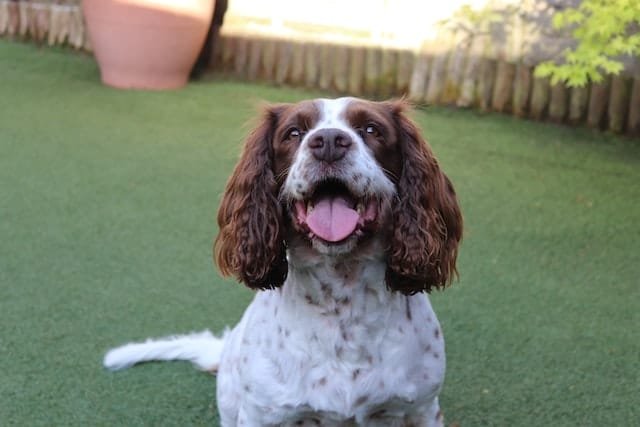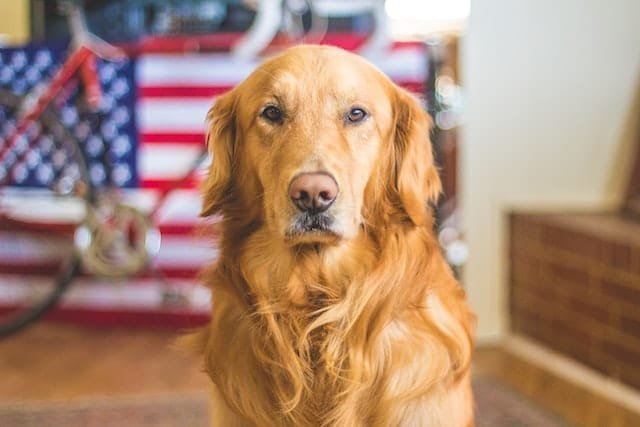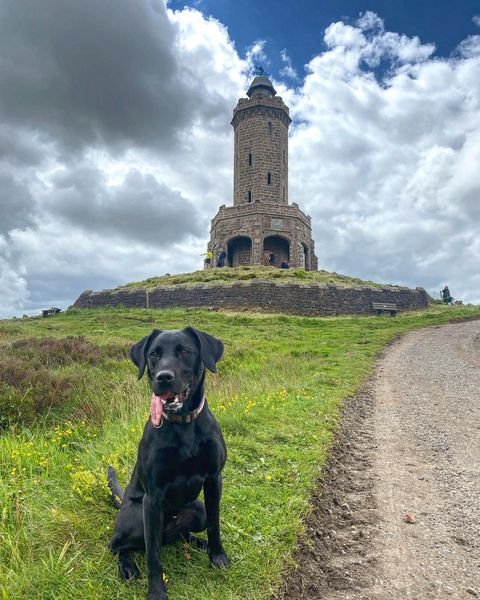The Springador is a very playful and friendly dog breed. This exciting personality trait, along with how adorable they always look, is why so many dog owners love having them in their homes.
Springador is a cross breed from Springer Spaniel and Labrador Retriever. They are sometimes called Labradingers because of their parent breeds. They pick up different traits from their parents to form the adorable Springadors we have around today.
If you were wondering whether a Springador is right for your household, you are in the right place. You can find out everything you need to know about this dog breed in this comprehensive guide.
Springador Facts and Figures Summary
| TRAITS | DETAILS |
|---|---|
| Name | Springador |
| Other names | Springer Spaniel Lab Mix, Labradinger |
| Parents | Springer Spaniel and Labrador Retriever |
| Life span | 10 – 14 years |
| Height | 18 – 24 inches |
| Weight | 50 – 90 lbs |
| Personality | Loving, active and playful |
| Temperament | Loyal and friendly |
| Shedding Level | Medium to High |
| Puppy cost | $300 – $900 |
What is a Springador Mix?
Springadors come from a mix of the Springer Spaniel and the Labrador Retriever. This breed is known to be friendly, active and intelligent. If their personality fits your home, then they are fun to have running around. To fully understand what the Springador Mix is, we need to look at the history and characteristics of its parent breeds.


The English Springer Spaniels’ history can be traced to centuries back when they were used for hunting upland birds. As hunting tools developed, they were later used as efficient gundogs. The spaniel will detect the bird, flush it from its cover, and it will retrieve the bird after it has been brought down. After years of performing this type of activity, the Springer Spaniels still have that active nature and intelligence to date.
Labrador Retrievers are a very popular breed today. Just like the Springer Spaniels, they also have some history of being used for hunting. They move in water with ease, so they were used to retrieve ducks and similar prey. Their kind and lovely nature eventually made them easily adapted as household dogs.
Springador Health & Appearance at a Glance
As a designer breed, Springadors can take different build characteristics from different parents. It generally depends on how they were bred. This means one Springador can look fairly different from another. However, we have identified some common characteristics you will find in almost every Springador you will see around.

Build, Height and Weight
Springadors are a fairly large breed. Their parents, especially the Labrador Retrievers, are known to be big dogs generally, and this designer breed carries this build too. Their size and agility are what make them fit for activities like hunting, retrieving prey and similar outdoor activities.
In weight, they will be somewhere between 50 and 90 lbs. In height, they could range from about 18 inches to as tall as 24 inches. Springadors that become as tall as 24 inches take that dominant trait from their Labrador Retriever parent. The labs are almost always taller than the Springer Spaniels.
Colors and Coat
Your dog might take the Lab’s short coat or the long, silky coat of the English Springer Spaniel. Generally, the coats on this breed of dogs are usually medium length, and with weekly brushing, they will be fine. They are also usually either high or medium shedding dogs, so their grooming needs to be handled efficiently.
Labradingers will take on black, brown, or gold-colored coats. Some dogs also have white markings on different regions of their furry coats.
Life Expectancy and Possible Health Issues
The life expectancy of Springadors is between ten and fourteen years. Generally, Springadors are a healthy breed. Once they are properly groomed, adequately fed and meet their exercise requirements, they should be alright.
Judging from their parent breeds, they could also be prone to obesity, elbow and hip dysplasia, and eye problems. Cleaning their long, floppy ears regularly is very important for these dogs. Dogs with long furry ears are prone to ear infections, but proper grooming can prevent them from becoming a problem with your dog.
Most of these health issues will not affect your Springadors’ life expectancy if you take them for regular vet check-ups. If they are detected early, they can be eliminated, and your furry friend will return to his happy, healthy life.
Springador Personality Traits
Friendliness is a common characteristic in all Springadors. They enjoy being around people and can easily form bonds and loyalty to humans around them. This trait makes them great household dogs, but it also means they do not enjoy being left alone for many hours. This is very important for anyone looking to get a Springador as a household pet. If your house is going to be empty for the larger part of the day, then these dogs might not be for you.
Springadors are also really active dogs. From their history, their parent breeds used to do a lot of running and different outdoor activities. The Springador today still needs to spend a lot of time being active and stimulated.
Springador Temperament and Instincts
Springadors are generally calm and friendly dogs. If they bark there might be a good reason for it, depending on how well they were trained. They are great around people, but they should not be left with children without supervision.
They are really active dogs, so they could instinctively get triggered when they spot prey. This means when you are outside on a walk or in the park, you should have a leash on your Springador.
How to Care for a Springador?
Care is very important for Springadors. They do not need too much from their owners, but what they require must be delivered properly. Proper care will ensure the dog is able to live a healthy and active life with a happy household.

These are the things you need to take note of when administering care to a Springer Spaniel Lab Mix dog.
Grooming and Shedding
The type of coat on a Labradinger depends on which parent breed it gets that dominant trait from. It could be long and silky, or it could be short. Generally, long-haired dogs require some more brushing down than short-haired dogs.
This dog breed ranges from medium to heavy shedding depending on the specific type of coat each specific dog has. This means they have to be brushed down regularly. For long-haired dogs, brushing them down every day, or at least every other day will be sufficient to keep their fur healthy. For the shorter-haired dogs, once a week or twice a week will be enough.
Also, give your furry friend a full bath at least once every month. Ensure the hair in his ears are trimmed and cleaned regularly to keep infections away.
Diet and Feeding
Every Springador’s diet must be handled carefully. They need to be well fed, but they should also not be overfed to prevent obesity.
Naturally, the parent breeds of these dogs were very hardworking, so they burnt a lot of calories outside. Since your Springador spends a lot of time indoors, he is not performing as many activities as he actually can. If he gets overfed, the dog will eventually become obese, leading to other advanced health complications.
Specific feeding requirements depend on the size and build of the dog, so this information is best gotten in person from a vet doctor. For a regular-sized Springador, 2 cups of dog food served twice daily should be sufficient.
Activity and Exercise Requirements
Springadors are at their best when they are able to get enough physical and mental stimulation. This dog breed is very active, so they need to be given as much activity as they can get. A minimum of an hour of some outside exercise will be good for a Springador. This can be a walk, a run, or some time playing around in the park.
Also, he needs some mental stimulation. Within the house, you can keep your dog busy with toys or basic puzzles to ensure he is happy. Labradingers also enjoy people’s company, so there should be someone at home for most of the day to keep them preoccupied and comfortable.
How to Train a Springador?
Intelligent dogs make training a lot easier for owners. Springadors are smart dogs, so they pick up on training cues quite fast. They are also very eager to please people, so they tend to pay rapt attention throughout the training processes.
When training this breed of dogs with positive reinforcement, you need to ensure you monitor the number of treats you give them. Their tendency to be obese when they do not get enough physical activity can be triggered by stuffing them with too many treats.
It is very important to train your Springador to return when called and also to calm down and stop chasing prey when you need them to. They have a natural instinct to chase prey with everything they have, and this can be a problem when you are going on a walk. Adequate training can help your dog unlearn this activity and restrain itself from blindly chasing prey when you call.
Known Springador Health Problems
Springadors are mostly healthy dogs. With sufficient grooming and regular checkups, they would be fine. For the long-haired ones, their grooming needs to be taken seriously because long-haired dogs could develop different skin infections when they are not properly taken care of. Labradingers also have long, floppy ears that can house bacteria if they are not cleaned and checked regularly.

Asides from these, there are some common health problems that can be found in their parent breeds. Complications like hip and elbow dysplasia and eye problems. If they get overworked, they could also develop health complications from that, just like overfeeding can cause obesity.
Regular vet assessments are a good way to detect and resolve any of these complications early before they become major health problems.
Daily Routine for a Happy Springador
Your Springador’s days should start with a morning potty break. After this, you can go on a short stroll or jog to get him ready for the day. Springadors need a minimum of an hour of outside activity to stay healthy. You can split this outdoor activity to separate parts of the day, so it matches your schedule adequately.
After the morning exercise routine, your dog should be fed. For fully grown Labradingers they can receive two meals every day, once in the morning and then another in the evening. Pups might need to eat smaller servings about three to four times every day.
Is a Springador the Right Dog for You?
Springadors are great dogs, but they are not a perfect fit for every household out there. They aren’t high-maintenance dogs, but they need proper care. For one, they are friendly dogs that enjoy human company. If your house is not going to have anyone in it for most of the day, then you shouldn’t get this dog breed.
Also, they need at least an hour of outdoor activity daily. If you enjoy doing daily outdoor runs, a Springador will be great company for such. Also, a house with a yard or space for the dog to run around will really match the dog’s active personality.
Should You Buy Or Adopt A Springador?
Springador pups cost between $300 and $900. Sometimes it could be higher depending on the breeder. However, adopting a Springador from a rescue home would cost less.
If you are interested in getting all the information about the dog’s history, health, parents and similar details, buying a pup might be better for you. But if you are more concerned about cost, then you should go for adoption.
FAQs about the Springador Cross-Breed
A Springador pup costs between $300 and $900. The price may vary with different breeders, but this is the general range of pricing for Springador pups. However, adoption generally costs less than the amount you will pay at the breeder’s.
Yes, Springadors are either medium or heavy shedders depending on the parent breed they get their coat from. They are not the ideal dogs to have around people with allergies. This also means their grooming should be taken seriously.
Their life expectancy is between ten and fourteen years. So, they tend to live as long as most other dog breeds. Springadors also have minimal health issues and would spend a greater part of their lifespan healthy.
This is a designer dog breed, so it is prone to the same health problems its parent breeds are prone to. Some common ones are elbow and hip dysplasia, and eye problems. If they are not properly cared for, they could also develop skin or ear infections, or obesity.
Springadors are loving and playful dogs, so they enjoy people’s company. They are great household dogs and get along well with adults and children alike. However, you should not leave the dog and children alone unsupervised.
No, these dogs are not hypoallergenic. They are usually either medium or heavy shedders, and neither is good for a person with allergies.
Naturally, Springadors are instinctive hunters, so they might take smaller animals or cats to be prey that should be chased. However, they are also intelligent dogs, so you can train them to live comfortably with other pets. If you can train your dog not to chase other household animals early, they will all get along fine.
